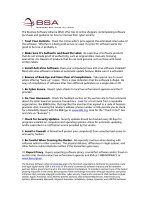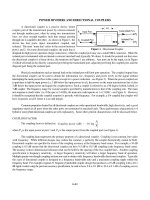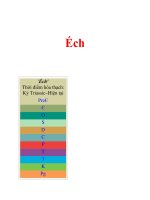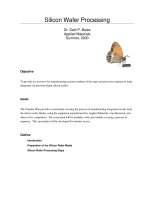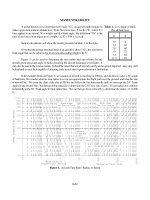Tài liệu Couplers pdf
Bạn đang xem bản rút gọn của tài liệu. Xem và tải ngay bản đầy đủ của tài liệu tại đây (87.18 KB, 5 trang )
Transmitted Port
Coupled Port
Input Port
Isolated Port
1
4
2
3
P
1
P
3
P
P
2
4
8/4
Coupling factor (dB) ' &10 log
P
3
P
1
6-4.1
Figure 1. Directional Coupler
POWER DIVIDERS AND DIRECTIONAL COUPLERS
A directional coupler is a passive device which
couples part of the transmission power by a known amount
out through another port, often by using two transmission
lines set close enough together such that energy passing
through one is coupled to the other. As shown in Figure 1, the
device has four ports: input, transmitted, coupled, and
isolated. The term "main line" refers to the section between
ports 1 and 2. On some directional couplers, the main line is
designed for high power operation (large connectors), while the coupled port may use a small SMA connector. Often the
isolated port is terminated with an internal or external matched load (typically 50 ohms). It should be pointed out that since
the directional coupler is a linear device, the notations on Figure 1 are arbitrary. Any port can be the input, (as in Figure
3) which will result in the directly connected port being the transmitted port, adjacent port being the coupled port, and the
diagonal port being the isolated port.
Physical considerations such as internal load on the isolated port will limit port operation. The coupled output from
the directional coupler can be used to obtain the information (i.e., frequency and power level) on the signal without
interrupting the main power flow in the system (except for a power reduction - see Figure 2). When the power coupled out
to port three is half the input power (i.e. 3 dB below the input power level), the power on the main transmission line is also
3 dB below the input power and equals the coupled power. Such a coupler is referred to as a 90 degree hybrid, hybrid, or
3 dB coupler. The frequency range for coaxial couplers specified by manufacturers is that of the coupling arm. The main
arm response is much wider (i.e. if the spec is 2-4 GHz, the main arm could operate at 1 or 5 GHz - see Figure 3). However
it should be recognized that the coupled response is periodic with frequency. For example, a 8/4 coupled line coupler will
have responses at n8/4 where n is an odd integer.
Common properties desired for all directional couplers are wide operational bandwidth, high directivity, and a good
impedance match at all ports when the other ports are terminated in matched loads. These performance characteristics of
hybrid or non-hybrid directional couplers are self-explanatory. Some other general characteristics will be discussed below.
COUPLING FACTOR
The coupling factor is defined as:
where P is the input power at port 1 and P is the output power from the coupled port (see Figure 1).
1 3
The coupling factor represents the primary property of a directional coupler. Coupling is not constant, but varies
with frequency. While different designs may reduce the variance, a perfectly flat coupler theoretically cannot be built.
Directional couplers are specified in terms of the coupling accuracy at the frequency band center. For example, a 10 dB
coupling ± 0.5 dB means that the directional coupler can have 9.5 dB to 10.5 dB coupling at the frequency band center.
The accuracy is due to dimensional tolerances that can be held for the spacing of the two coupled lines. Another coupling
specification is frequency sensitivity. A larger frequency sensitivity will allow a larger frequency band of operation.
Multiple quarter-wavelength coupling sections are used to obtain wide frequency bandwidth directional couplers. Typically
this type of directional coupler is designed to a frequency bandwidth ratio and a maximum coupling ripple within the
frequency band. For example a typical 2:1 frequency bandwidth coupler design that produces a 10 dB coupling with a ±0.1
dB ripple would, using the previous accuracy specification, be said to have 9.6 ± 0.1 dB to 10.4 ± 0.1 dB of coupling across
the frequency range.
30
25
20
15
10
5
0
0.01 0.1 1.0
Main Arm (Insertion) Loss - dB
Coupling Insertion
dB Loss - dB
3
6
10
20
30
3.00
1.25
0.458
0.0436
0.00435
F2
F1 + F2
P1
10 dB
F1
P3
P2
Isolators (Section 6.7)
Insertion loss (dB) ' 10 log 1 &
P
3
P
1
Isolation (dB) ' &10 log
P
4
P
1
Isolation (dB) ' &10 log
P
3
P
2
6-4.2
Figure 2. Coupling Insertion Loss
Figure 3. Two-Tone Receiver Tests
LOSS
In an ideal directional coupler, the main line
loss port 1 to port 2 (P - P ) due to power coupled
1 2
to the coupled output port is:
The actual directional coupler loss will be
a combination of coupling loss, dielectric loss,
conductor loss, and VSWR loss. Depending on the
frequency range, coupling loss becomes less
significant above 15 dB coupling where the other
losses constitute the majority of the total loss. A graph of the theoretical insertion loss (dB) vs coupling (dB) for a
dissipationless coupler is shown in Figure 2.
ISOLATION
Isolation of a directional coupler can be defined as the difference in signal levels in dB between the input port and
the isolated port when the two output ports are terminated by matched loads, or:
Isolation can also be defined between the two output ports. In this case, one of the output ports is used as the input;
the other is considered the output port while the other two ports (input and isolated) are terminated by matched loads.
Consequently:
The isolation between the input and the isolated ports may be different from the isolation between the two output
ports. For example, the isolation between ports 1 and 4 can be 30 dB while the isolation between ports 2 and 3 can be a
different value such as 25 dB. If both isolation measurements are not available, they can assumed to be equal. If neither
are available, an estimate of the isolation is the coupling plus return loss (see VSWR section). The isolation should be as
high as possible. In actual couplers the isolated port is never completely isolated. Some RF power will always be present.
Waveguide directional couplers will have the best isolation.
If isolation is high, directional couplers are
excellent for combining signals to feed a single line to a
receiver for two-tone receiver tests. In Figure 3, one signal
enters port P and one enters port P , while both exit port
3 2
P . The signal from port P to port P will experience 10
1 3 1
dB of loss, and the signal from port P to port P will have
2 1
0.5 dB loss. The internal load on the isolated port will
dissipate the signal losses from port P and port P . If the
3 2
isolators in Figure 3 are neglected, the isolation
measurement (port P to port P ) determines the amount of
2 3
power from the signal generator F that will be injected into
2
the signal generator F . As the injection level increases, it
1
may cause modulation of signal generator F , or even
1
Directivity (dB) ' &10 log
P
4
P
3
' &10 log
P
4
P
1
% 10 log
P
3
P
1
6-4.3
injection phase locking. Because of the symmetry of the directional coupler, the reverse injection will happen with the same
possible modulation problems of signal generator F by F . Therefore the isolators are used in Figure 3 to effectively
2 1
increase the isolation (or directivity) of the directional coupler. Consequently the injection loss will be the isolation of the
directional coupler plus the reverse isolation of the isolator.
DIRECTIVITY
Directivity is directly related to Isolation. It is defined as:
where: P is the output power from the coupled port and P is the power output from the isolated port.
3 4
The directivity should be as high as possible. Waveguide directional couplers will have the best directivity. Directivity is
not directly measurable, and is calculated from the isolation and coupling measurements as:
Directivity (dB) = Isolation (dB) - Coupling (dB)
HYBRIDS
The hybrid coupler, or 3 dB directional coupler, in which the two outputs are of equal amplitude takes many forms.
Not too long ago the quadrature (90 degree) 3 dB coupler with outputs 90 degrees out of phase was what came to mind
when a hybrid coupler was mentioned. Now any matched 4-port with isolated arms and equal power division is called a
hybrid or hybrid coupler. Today the characterizing feature is the phase difference of the outputs. If 90 degrees, it is a 90
degree hybrid. If 180 degrees, it is a 180 degree hybrid. Even the Wilkinson power divider which has 0 degrees phase
difference is actually a hybrid although the fourth arm is normally imbedded.
Applications of the hybrid include monopulse comparators, mixers, power combiners, dividers, modulators, and
phased array radar antenna systems.
AMPLITUDE BALANCE
This terminology defines the power difference in dB between the two output ports of a 3 dB hybrid. In an ideal
hybrid circuit, the difference should be 0 dB. However, in a practical device the amplitude balance is frequency dependent
and departs from the ideal 0 dB difference.
PHASE BALANCE
The phase difference between the two output ports of a hybrid coupler should be 0, 90, or 180 degrees depending
on the type used. However, like amplitude balance, the phase difference is sensitive to the input frequency and typically
will vary a few degrees.
The phase properties of a 90 degree hybrid coupler can be used to great advantage in microwave circuits. For
example in a balanced microwave amplifier the two input stages are fed through a hybrid coupler. The FET device normally
has a very poor match and reflects much of the incident energy. However, since the devices are essentially identical the
reflection coefficients from each device are equal. The reflected voltage from the FETs are in phase at the isolated port and
are 180E different at the input port. Therefore, all of the reflected power from the FETs goes to the load at the isolated port
and no power goes to the input port. This results in a good input match (low VSWR).
0E
180E
Sum Difference
6-4.4
Figure 4. Balanced Antenna Input
Figure 5. Power Divider
If phase matched lines are used for an antenna input
to a 180E hybrid coupler as shown in Figure 4, a null will
occur directly between the antennas. If you want to receive
a signal in that position, you would have to either change the
hybrid type or line length. If you want to reject a signal
from a given direction, or create the difference pattern for a
monopulse radar, this is a good approach.
OTHER POWER DIVIDERS
Both in-phase (Wilkinson) and quadrature (90E) hybrid couplers
may be used for coherent power divider applications. The Wilkinson's
power divider has low VSWR at all ports and high isolation between
output ports. The input and output impedances at each port is designed
to be equal to the characteristic impedance of the microwave system. A
typical power divider is shown in Figure 5. Ideally, input power would be
divided equally between the output ports. Dividers are made up of
multiple couplers, and like couplers, may be reversed and used as
multiplexers. The drawback is that for a four channel multiplexer, the
output consists of only 1/4 the power from each, and is relatively
inefficient. Lossless multiplexing can only be done with filter networks.
Coherent power division was first accomplished by means of
simple Tee junctions. At microwave frequencies, waveguide tees have two
possible forms - the H-Plane or the E-Plane. These two junctions split
power equally, but because of the different field configurations at the
junction, the electric fields at the output arms are in-phase for the H-Plane tee and are anti-phase for the E-Plane tee. The
combination of these two tees to form a hybrid tee allowed the realization of a four-port component which could perform
the vector sum (E) and difference ()) of two coherent microwave signals. This device is known as the magic tee.
IN
IN
IN
IN
IN
IN
IN
SIGNAL
INPUT
90E- 3dB
0E- 3dB
0E- 6dB
90E- 6dB
90E- 6dB
180E- 6dB
180E- 9dB
180E- 9dB
90E- 9dB
270E- 9dB
90E- 9dB
90E- 9dB
0E- 9dB
180E- 9dB
270E+31dB
180E+31dB
180E+31dB
90E+31dB
90E+31dB
180E+31dB
90E+31dB
0E+31dB
90E+34dB
180E+34dB
180E+34dB
270E+34dB
270E+37dB
180E+37dB
270E+40dB
ANTENNA
OUTPUT
+40 dB SOLID STATE AMPLIFIERS (SSAs)
(Voltage Gain of 100)
NOTE: All isolated ports of the hybrids have matched terminations. They have signals which are out of phase and cancel
90E
180E
Output
90E, 270E
Signals Cancel
Output
180E, 180E
Signals Add
TYPICAL HYBRID SIGNAL ADDITION
If 180E out of phase, signals cancel
and there is zero watts received
If in phase, the signals add, so
there would be 2 watts received
Any other phase relationship will produce a
signal somewhere between 0 and 2 watts.
This shows signals that are 90E out of phase.
The phase error could be due to a hybrid being used to combine the same signal received from two aircraft antennas.
Signal
A
Signal
B
Signal
A + B
6-4.5
Figure 6. Combiner Network
Figure 7. Sinewaves Combined Using Various Phase Relationships
POWER COMBINERS
Since hybrid circuits are bi-directional, they can be used to split up a signal to feed multiple low power amplifiers,
then recombine to feed a single antenna with high power as shown in Figure 6. This approach allows the use of numerous
less expensive and lower power amplifiers in the circuitry instead of a single high power TWT. Yet another approach is
to have each solid state amplifier (SSA) feed an antenna and let the power be combined in space or be used to feed a lens
which is attached to an antenna. (See Section 3-4)
Sample Problem:
If two 1 watt peak unmodulated RF carrier signals at 10 GHz are received, how much peak power could one
measure?
A. 0 watts
B. 0.5 watts
C. 1 watt
D. 2 watts
E. All of these
The answer is all of
these as shown in
Figure 7.


